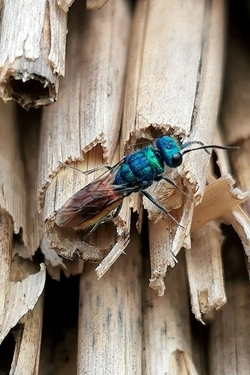Ruby-tailed wasp
 Well, the mantle has been passed, and after many enlightening years of reading Species of the Month from the outside, I am now to be the author as the newly appointed GWCT Farmland Biodiversity Advisor, and following Pete and Jess is quite a high bar, but here goes!
Well, the mantle has been passed, and after many enlightening years of reading Species of the Month from the outside, I am now to be the author as the newly appointed GWCT Farmland Biodiversity Advisor, and following Pete and Jess is quite a high bar, but here goes!
On a recent long weekend staycation in Hampshire celebrating my birthday, I had the pleasure of a “busman’s holiday” trip to Butser Ancient Farm for the day. For those who haven’t had the pleasure of visiting, it is a unique experimental archaeological site nestled into the rolling landscape of the South Downs.
The farm features archaeological reconstructions of ancient buildings from the Stone Age, Iron Age, Roman Britain and the Anglo-Saxon period, and crops are grown from prehistory and rare breeds of animals are kept, such as goats, pigs and sheep. It is like looking through the window of time and coming away with the smell of woodsmoke in your hair from fires burning in the roundhouses and a acquiring the new skill of writing in Anglo-Saxon runes.
This isn’t much of a species account, I hear you say, but I’m setting the scene! While standing outside of one of the Saxon longhouses, something caught my eye in the wheat straw thatch roof, which comes down to shoulder height. A glinting metallic red jewel-like gem flying fast and running with intent in and around the straw ends, and it was nothing quite like anything I’ve seen before. After watching it for some time go about its business, I managed to get some photos to aid me in the quest to identify what it was.
It was a ruby-tailed wasp (Chrysis ignita), perhaps one of the UK’s most beautiful tiny insects, barely 10mm in length with its bright red, blue, green and bronze metallic colours, which can be found across the UK from April through to September. So, as I knew nothing about it and haven’t seen one before, it had to be my first Species of the Month!
This glittering metallic ruby-tailed wasp has other names – cuckoo wasp or emerald wasp – with the latter being obvious, and the former will become clearer! To make things more difficult, there are several species found in the UK that are commonly grouped as being ruby-tailed wasps, some of them are quite rare and all are difficult to tell apart.
They are all part of the family Chrysididae, which is a large group of parasitoid and kleptoparastic wasps – kleptoparasite is an animal that takes food from another that has either caught, collected, or otherwise prepared the food, including stored food. The ruby-tailed wasp is one of many species of solitary wasps and bees, which do not live in colonies, but instead they live a solitary life, not making their owns nests but laying its eggs in a host nest.
Once a female has found the nest of a host insect, mainly mason bees and other solitary bees, it explores the entrance to make sure that there are no adults in occupancy – which is exactly what the one I was watched was doing: it was checking the ends/holes of the straw on the thatched roof to see if there were any nest opportunities and if the hosts were present. If the ruby-tailed wasp was to encounter an angry resident, it is well equipped to defend itself; it has a very hard body cuticle protecting it from stings and it has the ability to roll itself into a ball.
When the wasp finds a host nest without an adult present, it reverses into the host nest hole and lays its eggs next to the host eggs. The wasp eggs hatch into larvae, which then eat the eggs/larvae of the host species. The unsuspecting host returns to seal the nest hole, not knowing the ruby-tailed wasp is inside – this is why this wasp is also known as the cuckoo wasp! The larva completes their development inside the nest and the adults emerge the following spring, and so the cycle starts all over again.
It did make me wonder what Alfred the Great would have made of this little insect, so keep an eye out for this beautiful parasitic solitary wasp – it truly is a beauty to behold.
Megan Lock
Advisory